Fluoride Fiber-Based Plasmonic Biosensor with Two-Dimensional Material Heterostructures: Enhancement of Overall Figure-of-Merit via Optimization of Radiation Damping in Near Infrared Region
Abstract
1. Introduction
2. Theory and Design Consideration
3. Results and Discussion
3.1. Analysis of 2D (dm, λ) Variation of FOM for Sensor Designs with BlueP/WS2 & BlueP/MoS2 Heterostructures
3.2. Comparative Analysis between BlueP/WS2 and BlueP/MoS2 Heterostructure-Based Sensor Designs
3.3. Field Analysis at Resonance Condition
3.4. Comprehensive Performance Analysis under ORD Conditions
- (i)
- the wavelength of sensor operation should ideally be as large as possible in the NIR range, owing to the lower photodamage of the analyte (biosamples, in particular) [42] and the smaller Rayleigh scattering factor, RSF (i.e., λ−4),
- (ii)
- the ratio (PLR) of peak PL (MET tissue) to peak PL (N tissue) under corresponding ORD conditions (as depicted in Figure 5) can be added as another performance element,
- (iii)
- as discussed in Section 3.3, field enhancement factor (FEF) is another possible inclusion to the sensor’s performance evaluation.
4. Conclusions
Author Contributions
Funding
Acknowledgments
Conflicts of Interest
References
- Balendhran, S.; Walia, S.; Nili, H.; Sriram, S.; Bhaskaran, M. Elemental analogues of graphene: Silicene, germanene, stanene, and phosphorene. Small 2015, 11, 640–652. [Google Scholar] [CrossRef] [PubMed]
- Rubio-Bollinger, G.; Guerrero, R.; de Lara, D.; Quereda, J.; Vaquero-Garzon, L.; Agraït, N.; Bratschitsch, R.; Castellanos-Gomez, A. Enhanced Visibility of MoS2, MoSe2, WSe2 and Black-Phosphorus: Making Optical Identification of 2D Semiconductors Easier. Electronics 2015, 4, 847–856. [Google Scholar] [CrossRef]
- Mas-Ballesté, R.; Gómez-Navarro, C.; Gómez-Herrero, J.; Zamora, F. 2D materials: To graphene and beyond. Nanoscale 2011, 3, 20–30. [Google Scholar] [CrossRef] [PubMed]
- Song, B.; Li, D.; Qi, W.; Elstner, M.; Fan, C.; Fang, H. Graphene on Au(111): A highly conductive material with excellent adsorption properties for high-resolution bio/nanodetection and identification. ChemPhysChem 2010, 11, 585–589. [Google Scholar] [CrossRef]
- Koppens, F.H.L.; Chang, D.E.; de Abajo, F.J. Graphene Plasmonics: A Platform for Strong Light-Matter Interactions. Nano Lett. 2011, 11, 3370–3377. [Google Scholar] [CrossRef] [PubMed]
- Bonaccorso, F.; Sun, Z.; Hasan, T.; Ferrari, A.C. Graphene Photonics and Optoelectronics. Nat. Photonics 2010, 4, 611–622. [Google Scholar] [CrossRef]
- Wu, L.; Guo, J.; Wang, Q.; Lu, S.; Dai, X.; Xiang, Y.; Fan, D. Sensitivity enhancement by using few-layer black phosphorus-graphene/TMDCs heterostructure in surface plasmon resonance biochemical sensor. Sens. Actuators B Chem. 2017, 249, 542–548. [Google Scholar] [CrossRef]
- Novoselov, K.S.; Mishchenko, A.; Carvalho, A.; Neto, A.H.C. 2D materials and van der Waals heterostructures. Research 2016, 353, aac9439. [Google Scholar]
- Mcgaughey, G.B.; Gagne, M.; Rappe, A.K. π-Stacking Interactions. J. Biol. Chem. 1998, 273, 15458–15463. [Google Scholar] [CrossRef]
- Kong, L.; Enders, A.; Rahman, T.S.; Dowben, P. A Molecular adsorption on graphene. J. Phys. Condens. Matter 2014, 26, 443001. [Google Scholar]
- Zhao, Y.; Li, X.; Zhou, X.; Zhang, Y. Review on the graphene based optical fiber chemical and biological sensors. Sens. Actuators B Chem. 2016, 231, 324–340. [Google Scholar] [CrossRef]
- Maharana, P.K.; Srivastava, T.; Jha, R. On the Performance of Highly Sensitive and Accurate Graphene-on-Aluminum and Silicon-Based SPR Biosensor for Visible and Near Infrared. Plasmonics 2014, 9, 1113–1120. [Google Scholar] [CrossRef]
- Pandey, A.K.; Sharma, A.K. Simulation and analysis of plasmonic sensor in NIR with fluoride glass and graphene layer. Photonics Nanostruct. Fundam. Appl. 2018, 28, 94–99. [Google Scholar] [CrossRef]
- Wu, L.; Guo, J.; Dai, X.; Xiang, Y.; Fan, D. Sensitivity Enhanced by MoS2-Graphene Hybrid Structure in Guided-Wave Surface Plasmon Resonance Biosensor. Plasmonics 2017, 13, 281–285. [Google Scholar] [CrossRef]
- Wu, L.; Jia, Y.; Jiang, L.; Guo, J.; Dai, X.; Xiang, Y.; Fan, D. Sensitivity Improved SPR Biosensor Based on the MoS2/Graphene–Aluminum Hybrid Structure. J. Light. Technol. 2017, 35, 82–87. [Google Scholar] [CrossRef]
- Maurya, J.B.; Prajapati, Y.K.; Singh, V.; Saini, J.P.; Tripathi, R. Improved performance of the surface plasmon resonance biosensor based on graphene or MoS2 using silicon. Opt. Commun. 2016, 359, 426–434. [Google Scholar] [CrossRef]
- Sharma, A.K.; Pandey, A.K. Blue Phosphorene/MoS2 Heterostructure based SPR Sensor with Enhanced Sensitivity. IEEE Photonics Technol. Lett. 2018, 30, 595–598. [Google Scholar] [CrossRef]
- Liang, G.; Luo, Z.; Liu, K.; Wang, Y.; Dai, J.; Duan, Y. Fiber Optic Surface Plasmon Resonance–Based Biosensor Technique: Fabrication, Advancement, and Application. Crit. Rev. Anal. Chem. 2016, 46, 213–223. [Google Scholar] [CrossRef]
- Sharma, A.K.; Pandey, A.K.; Kaur, B. A Review of advancements (2007–2017) in plasmonics-based optical fiber sensors. Opt. Fiber Technol. 2018, 43, 20–34. [Google Scholar] [CrossRef]
- Fu, H.; Zhang, S.; Chen, H.; Weng, J. Graphene Enhances the Sensitivity of Fiber-Optic Surface Plasmon Resonance Biosensor. IEEE Sens. J. 2015, 15, 5478–5482. [Google Scholar] [CrossRef]
- Mishra, A.K.; Mishra, S.K.; Verma, R.K. Graphene and Beyond Graphene MoS2: A New Window in Surface-Plasmon-Resonance-Based Fiber Optic Sensing. J. Phys. Chem. C 2016, 120, 2893–2900. [Google Scholar] [CrossRef]
- Sharma, A.K.; Kaur, B. Fiber optic SPR sensing enhancement in NIR via optimum radiation damping catalyzed by 2D materials. IEEE Photonics Technol. Lett. 2018, 30. [Google Scholar] [CrossRef]
- Sharma, A.K.; Kaur, B. Simulation of multilayered heterojunction-based chalcogenide fiber SPR sensor with ultrahigh figure of merit in near infrared. IEEE Sens. J. 2019. [Google Scholar] [CrossRef]
- Peng, Q.; Wang, Z.; Sa, B.; Wu, B.; Sun, Z. Electronic structures and enhanced optical properties of blue phosphorene/transition metal dichalcogenides van der Waals heterostructures. Sci. Rep. 2016, 6, 31994. [Google Scholar] [CrossRef]
- Jariwala, D.; Davoyan, A.R.; Tagliabue, G.; Sherrott, M.C.; Wong, J.; Atwater, H.A. Near-Unity Absorption in van der Waals Semiconductors for Ultrathin Optoelectronics. Nano Lett. 2016, 16, 5482–5487. [Google Scholar] [CrossRef]
- ZBLAN Fluoride Glass Fibers & Cables. Available online: https://www.fiberlabs.com/fiberindex/fiber-stock (accessed on 30 April 2019).
- Sharma, A.K. Plasmonic biosensor for detection of hemoglobin concentration in human blood: Design considerations. J. Appl. Phys. 2013, 114. [Google Scholar] [CrossRef]
- Bendow, B.; Brown, R.N.; Lipson, H.G.; Drexhage, M.G.; Moynihan, C.T. Infrared edge absorption in fluorohafnate glass. Appl. Opt. 1982, 21, 4393–4395. [Google Scholar] [CrossRef]
- Tran, D.C.; Sigel, G.H.; Bendow, B. Heavy Metal Fluoride Glasses and Fibers: A Review. J. Lightw. Technol. 1984, 2, 566–586. [Google Scholar] [CrossRef]
- Pandey, A.K.; Sharma, A.K.; Basu, R. Fluoride Glass based Surface Plasmon Resonance Sensor in Infrared region: Performance Evaluation. J. Phys. D Appl. Phys. 2017, 50, 185103. [Google Scholar] [CrossRef]
- Ghatak, A.; Thyagarajan, K. An Introduction to Fiber Optics; Cambridge University Press: Cambridge, UK, 1998; ISBN 9780521577854. [Google Scholar]
- Li, H.H. Refractive index of alkaline earth halids and its wavelength and temperature derivatives. J. Phys. Chem. 1980, 9, 161–289. [Google Scholar]
- Rakic, A.D.; Djurisic, A.B.; Elazar, J.M.; Majewski, M.L. Optical properties of metallic films for vertical-cavity optoelectronic devices. Appl. Opt. 1998, 37, 5271–5283. [Google Scholar] [CrossRef]
- Giannios, P.; Toutouzas, K.G.; Matiatou, M.; Stasinos, K.; Konstadoulakis, M.M.; Zografos, G.C.; Moutzouris, K. Visible to near-infrared refractive properties of freshly-excised human-liver tissues: Marking hepatic malignancies. Sci. Rep. 2016, 6, 27910. [Google Scholar] [CrossRef]
- Ross, K.F.A.; Gordon, R.E. Water in malignant tissue, measured by cell refractometry and nuclear magnetic resonance. J. Microsc. 1982, 128, 7–21. [Google Scholar] [CrossRef]
- Palumbo, A.; Tourlomousis, F.; Chang, R.C.; Yang, E.-H. Influence of Transition Metal Dichalcogenide Surfaces on Cellular Morphology and Adhesion. ACS Appl. Biol. Mater. 2018, 1, 1448–1457. [Google Scholar] [CrossRef]
- Wolfram, T.; Vojak, B.A.; Edward, T.; Maas, J.; Burnham, R.D. Optically Pumped Laser. U.S. Patent 4,901,330, 13 February 1990. [Google Scholar]
- Lattice Trap Improves Optical Clocks. Available online: http://optics.org/article/22237 (accessed on 30 April 2019).
- Mao, Y.; Bao, Y.; Wang, W.; Li, Z.; Li, F.; Niu, L. Development and Application of Time-Resolved Surface Plasmon Resonance Spectrometer. Am. J. Anal. Chem. 2011, 2, 589–604. [Google Scholar] [CrossRef][Green Version]
- Li, L.; Zhang, X.; Liang, Y.; Guang, J.; Peng, W. Dual-channel fiber surface plasmon resonance biological sensor based on a hybrid interrogation of intensity and wavelength modulation. J. Biomed. Opt. 2016, 21, 127001. [Google Scholar] [CrossRef]
- Li, L.; Liang, Y.; Guang, J.; Cui, W.; Zhang, X.; Masson, J.-F.; Peng, W. Dual Kretschmann and Otto configuration fiber surface plasmon resonance biosensor. Opt. Express 2017, 25, 26950. [Google Scholar] [CrossRef]
- Ziblat, R.; Lirtsman, V.; Davidov, D.; Aroeti, B. Infrared surface plasmon resonance: A novel tool for real time sensing of variations in living cells. Biophys. J. 2006, 90, 2592–2599. [Google Scholar] [CrossRef]
- Sharma, A.K.; Kaur, B. Optical Fiber Technology Chalcogenide fiber-optic SPR chemical sensor with MoS 2 monolayer, polymer clad, and polythiophene layer in NIR using selective ray launching. Opt. Fiber Technol. 2018, 43, 163–168. [Google Scholar] [CrossRef]
- Popescu, V.; Puscas, N.; Perrone, G. The Sensing Characteristics of a Bragg Fiber Based Plasmonic Biosensor Using an As2S3 Chalcogenide Layer. Optics 2018, 6, 21–27. [Google Scholar] [CrossRef][Green Version]
- Xia, K.; Feng, X.; Yang, M.; Luo, Y.; Tang, J.; Guan, H.; Lu, H.; Yu, J.; Zhang, J.; Chen, Y.; et al. Long range surface plasmon resonance sensor based on side polished fiber with a buffer layer of magnesium fluoride. Opt. Quant. Electron. 2017, 49, 147. [Google Scholar]
- Bialiayeu, A.; Bottomley, A.; Prezgot, D.; Ianoul, A.; Albert, J. Plasmon-enhanced refractometry using silver nanowire coatings on tilted fibre Bragg gratings. Nanotechnology 2012, 23, 444012. [Google Scholar] [CrossRef] [PubMed]
- Gazzaz, K.; Berini, P. Theoretical biosensing performance of surface plasmon polariton Bragg gratings. Appl. Opt. 2015, 54, 1673. [Google Scholar] [CrossRef]

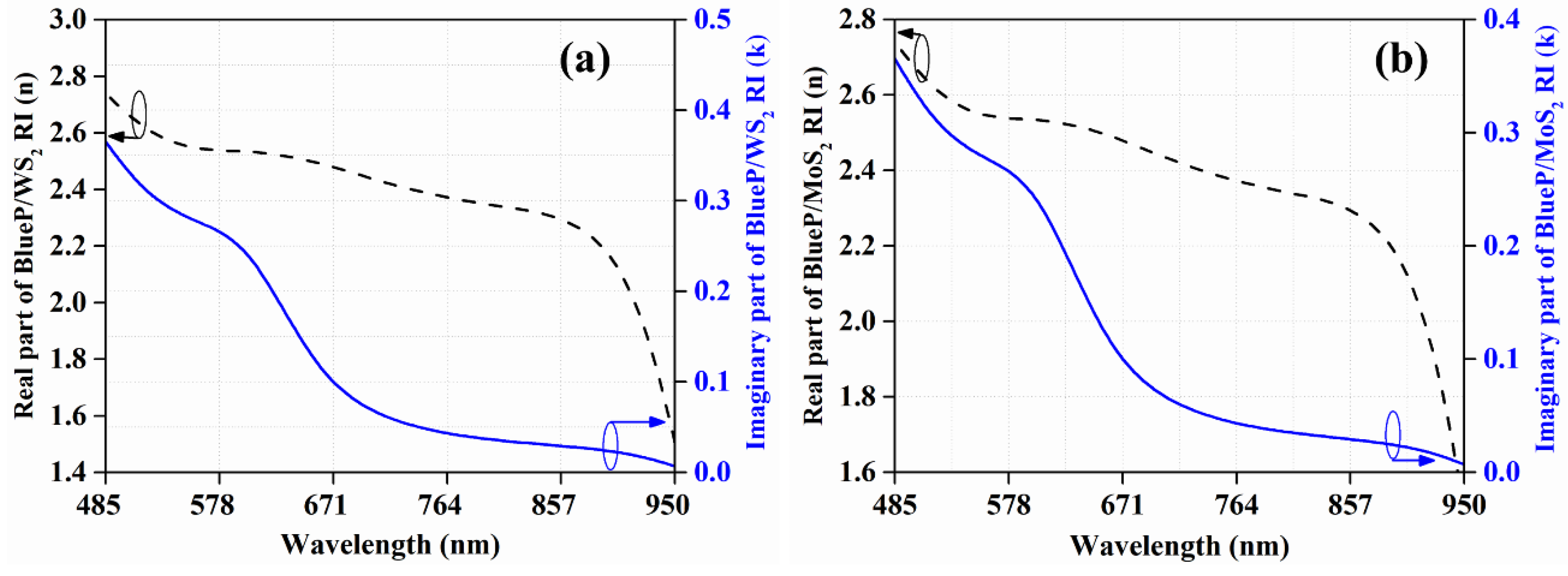
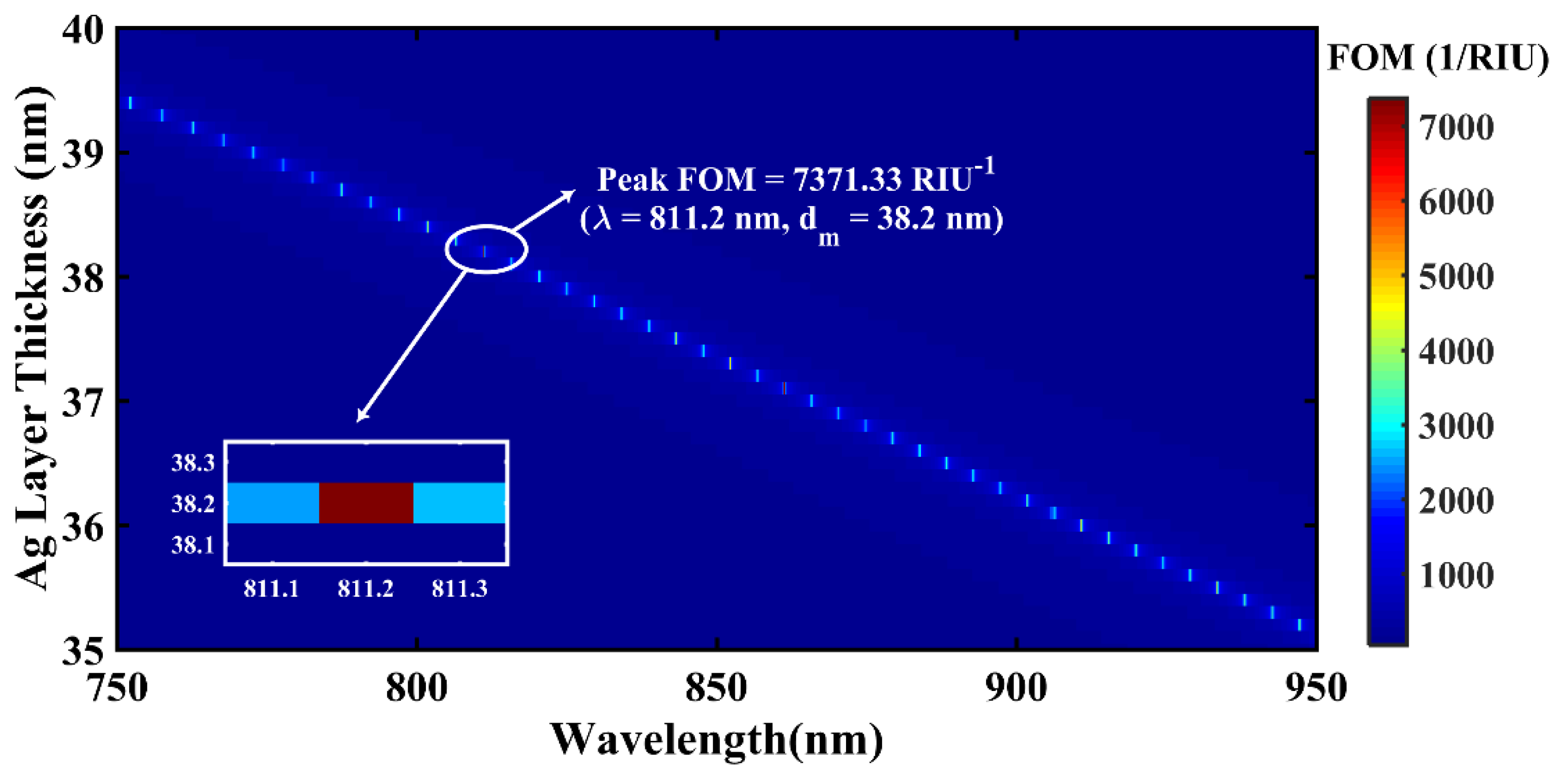
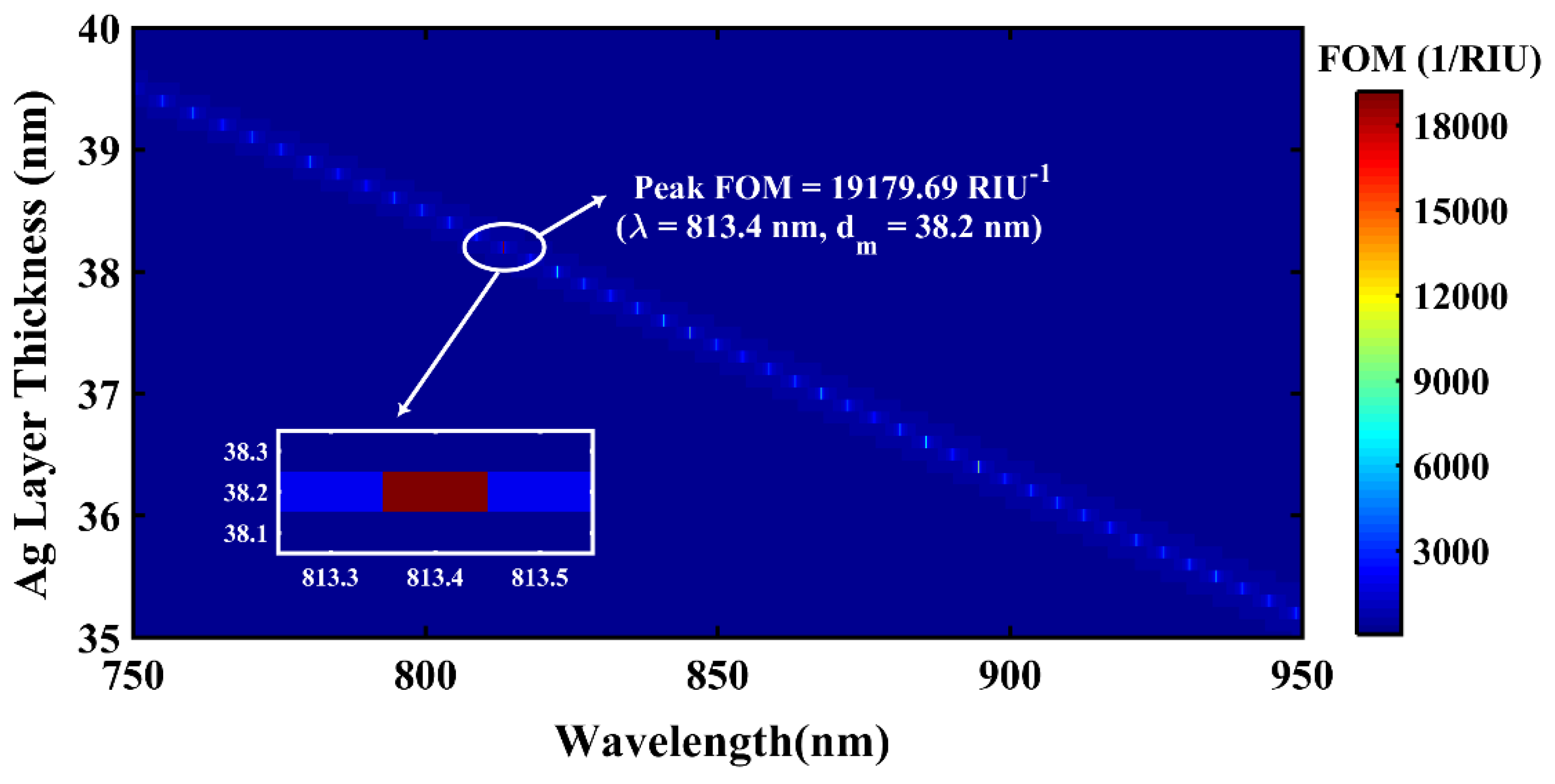
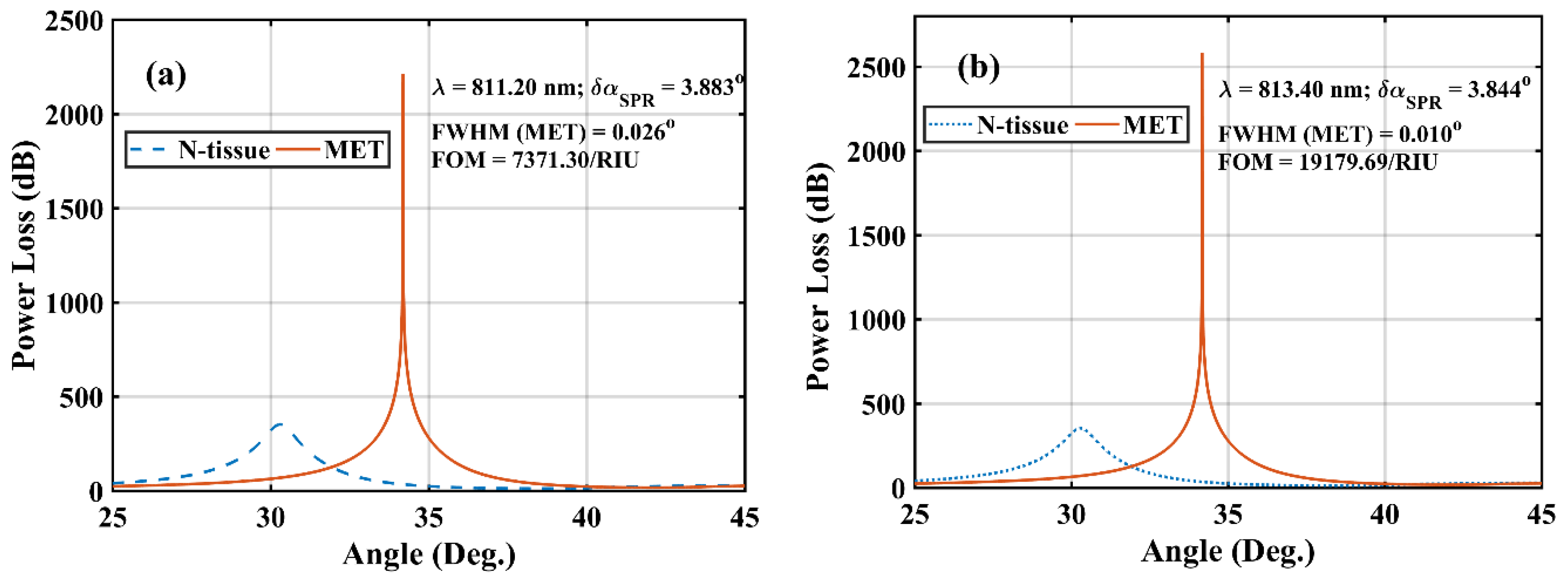
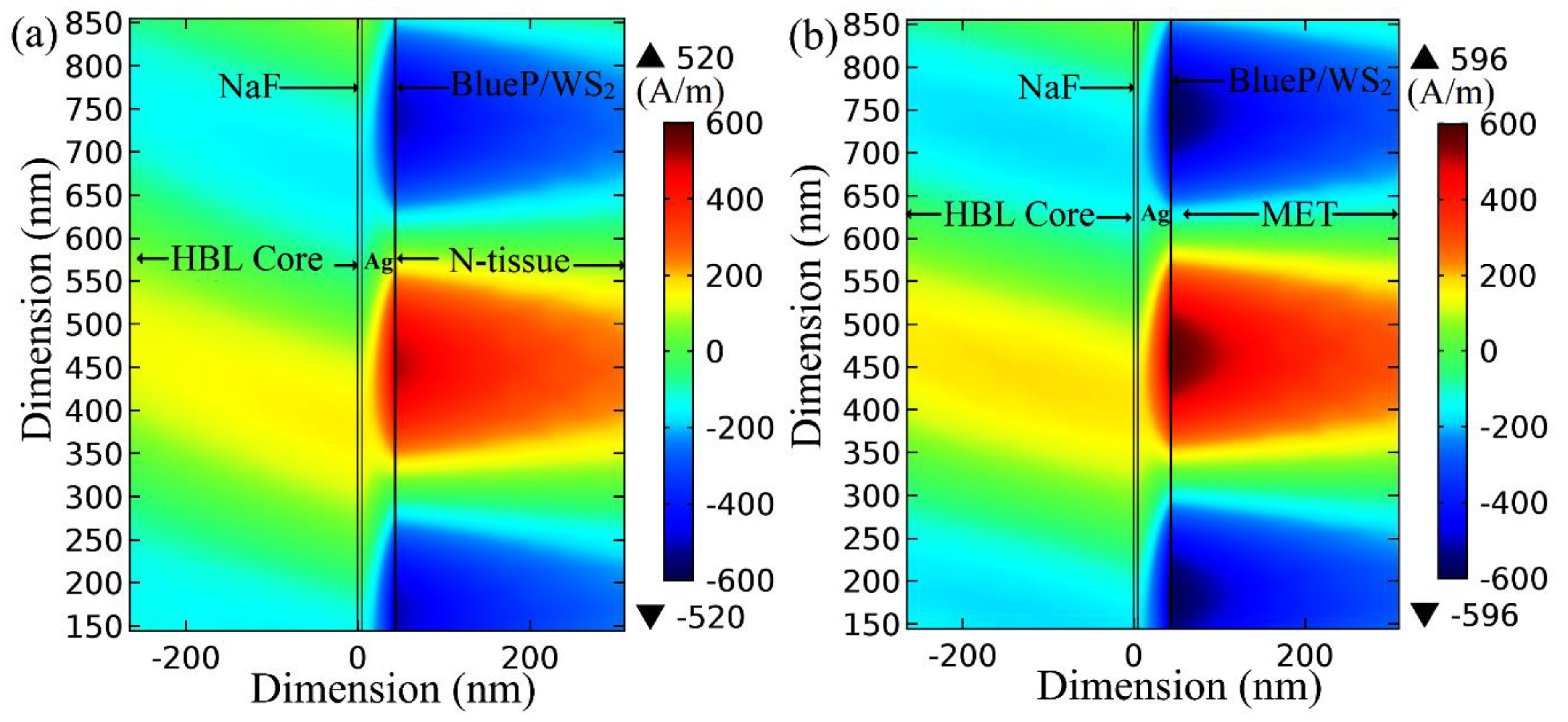
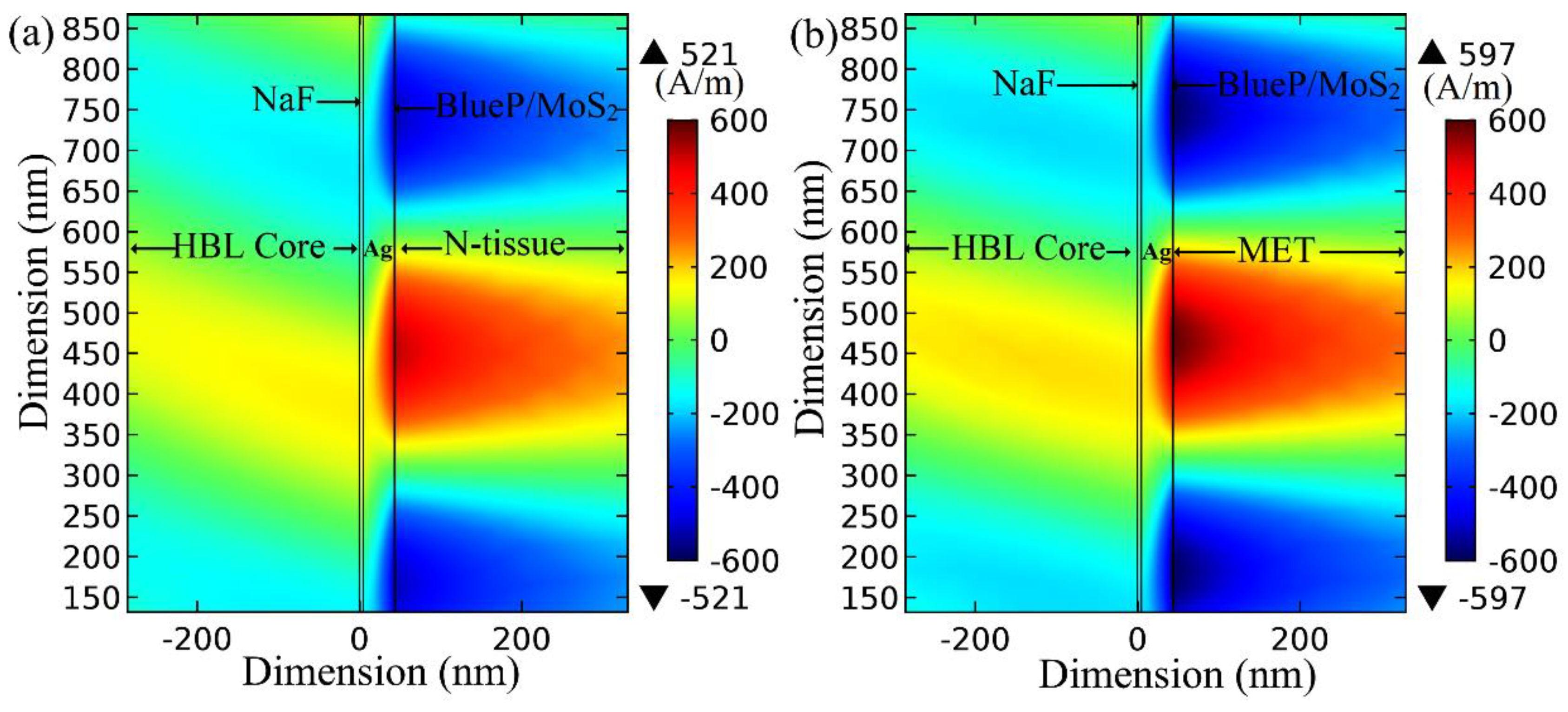
| S.N. | Monolayer 2D Heterostructure | dm (nm) | λ (nm) | δns (RIU) | δαSPR (°) | Sensitivity (°/RIU) | FWHM (°) | M-FOM (RIU−1) |
|---|---|---|---|---|---|---|---|---|
| 1 | BlueP/WS2 | 38.2 | 811.2 | 0.02026040 | 3.883 | 191.6547 | 0.026 | 7371.30 |
| 2 | BlueP/WS2 | 37.1 | 861.3 | 0.02004785 | 3.727 | 185.9052 | 0.026 | 7150.19 |
| 3 | BlueP/MoS2 | 38.2 | 813.4 | 0.02004203 | 3.844 | 191.7969 | 0.010 | 19,179.69 |
| 4 | BlueP/MoS2 | 36.4 | 894.7 | 0.01991865 | 3.649 | 183.1951 | 0.018 | 10,177.50 |
| Heterostructure | M-FOM (RIU−1) | λORD (µm) | RSF (µm−4) | PLR | FEF | C-FOM (µm4/RIU) |
|---|---|---|---|---|---|---|
| BlueP/MoS2 | 19,179.69 | 0.8134 | 2.284 | 7.317 | 1.14 | 70,046.01 |
| BlueP/WS2 | 7371.30 | 0.8112 | 2.301 | 6.263 | 1.14 | 22,871.63 |
| References | SPR Modalities | FOM (RIU−1) |
|---|---|---|
| Sharma and Kaur [22] | Samarium-doped fiber coated with 2D material | 6904.012 (graphene) 5897.082 (MoS2) |
| Sharma and Kaur [43] | Chalcogenide fiber sensor with polymer and 2D layer | 1647 (λ = 1200 nm) |
| Popescu et al. [44] | Bragg fiber with AS2S3 chalcogenide layer | 233.10 |
| Feng et al. [45] | Long range SPR on side-polished fiber with MgF2 layer | 156.19 |
| Bialiayeu et al. [46] | Tilted fiber Bragg gratings coated with silver nanowire | 3700 |
| Gazzaz and Berini [47] | Waveguide Bragg gratings supporting surface plasmons | 1000 |
| This work | Fluoride fiber coated with Ag layer (38.2 nm) and (BlueP/TMDs) heterostructure | 19,179.69 (BlueP/MoS2) 7371.30 (BlueP/WS2) |
© 2019 by the authors. Licensee MDPI, Basel, Switzerland. This article is an open access article distributed under the terms and conditions of the Creative Commons Attribution (CC BY) license (http://creativecommons.org/licenses/by/4.0/).
Share and Cite
Sharma, A.K.; Pandey, A.K.; Kaur, B. Fluoride Fiber-Based Plasmonic Biosensor with Two-Dimensional Material Heterostructures: Enhancement of Overall Figure-of-Merit via Optimization of Radiation Damping in Near Infrared Region. Materials 2019, 12, 1542. https://doi.org/10.3390/ma12091542
Sharma AK, Pandey AK, Kaur B. Fluoride Fiber-Based Plasmonic Biosensor with Two-Dimensional Material Heterostructures: Enhancement of Overall Figure-of-Merit via Optimization of Radiation Damping in Near Infrared Region. Materials. 2019; 12(9):1542. https://doi.org/10.3390/ma12091542
Chicago/Turabian StyleSharma, Anuj K., Ankit Kumar Pandey, and Baljinder Kaur. 2019. "Fluoride Fiber-Based Plasmonic Biosensor with Two-Dimensional Material Heterostructures: Enhancement of Overall Figure-of-Merit via Optimization of Radiation Damping in Near Infrared Region" Materials 12, no. 9: 1542. https://doi.org/10.3390/ma12091542
APA StyleSharma, A. K., Pandey, A. K., & Kaur, B. (2019). Fluoride Fiber-Based Plasmonic Biosensor with Two-Dimensional Material Heterostructures: Enhancement of Overall Figure-of-Merit via Optimization of Radiation Damping in Near Infrared Region. Materials, 12(9), 1542. https://doi.org/10.3390/ma12091542






